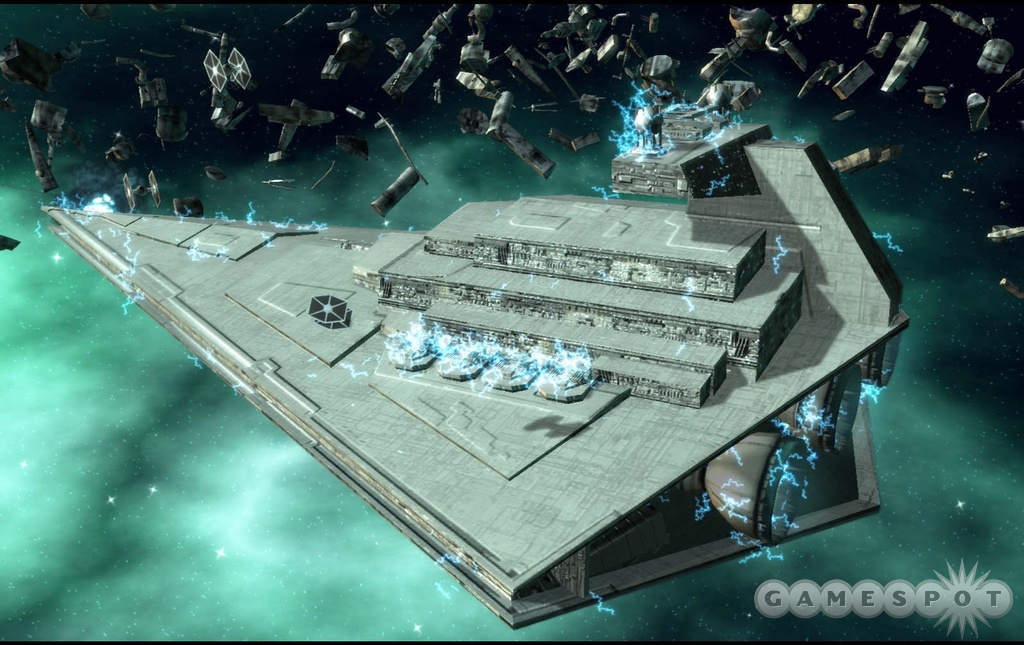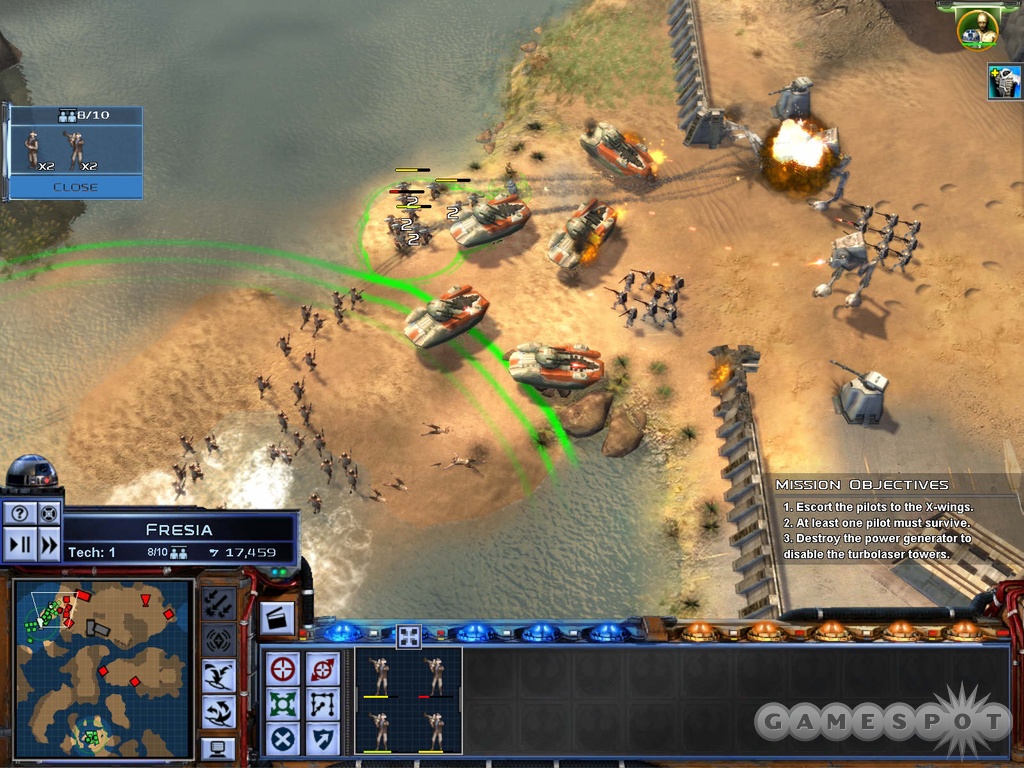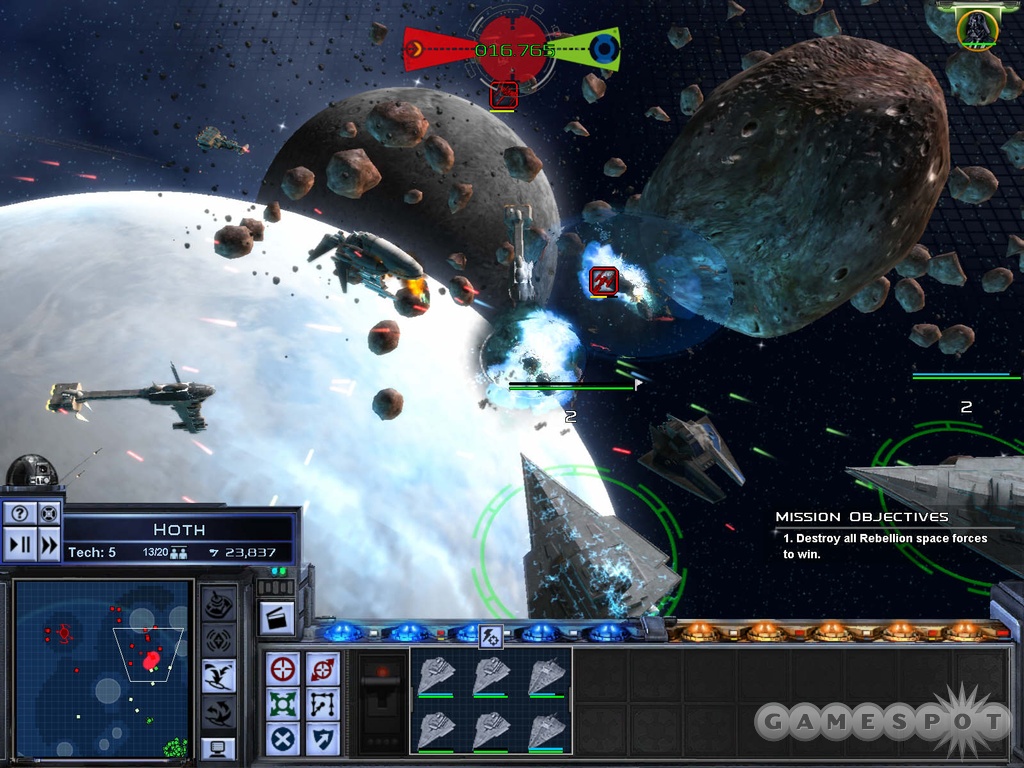The Star Wars franchise has seen its share of great action games, role-playing games, and space-combat simulators, but the strategy genre is something that, for some reason, has proved elusive for LucasArts to truly capture. The efforts to date, including Rebellion, Force Commander, and Galactic Battlegrounds, have ranged from poor to pretty good. Petroglyph's Empire at War is the game that's finally gotten the formula down just right. In Empire at War, the action takes place both in outer space and on the surface of planets, but the interconnection of the two is one of many important strategic aspects that you'll consider as you make your way through the campaign and galactic conquest scenarios. Logical differences in the optimal playing style between the Empire and Rebellion, as well as an epic presentation befitting of the license, contribute to a fantastic overall package that any strategy-game player can appreciate, whether you have a stormtrooper outfit in your closet or you just have a passing familiarity with the films.

The real-time action in Empire at War takes place on two different layers--a strategic layer, and a tactical aspect, which are the battles you fight in space and on land. The strategic layer takes place on a 2D galactic map, which shows all the planets in the galaxy. If you're playing the campaign, you'll worry about more than 40 different planets, while some of the galactic-conquest scenarios have as few as eight or 10 planets arrayed. Most planets can support space stations and land buildings such as barracks, mining facilities, factories, or even planetary defense systems like turbo-laser towers or massive ion cannons that shoot up into space. You can get more detailed information on a planet by zooming in on it, which gives you something of a Civ-lite view, listing all the units and structures there, as well as the things you can build on that planet. The Rebel side see all Empire-controlled planets on the galactic map, while the Empire must deploy probe droids to seek out the Rebels. The important thing to remember is that the action takes place in real time, even on the galactic map. So if you spend too much time considering what to build or where to send a fleet, you may invite the computer to attack one of your systems.
Some of the planets have unique bonuses, such as letting you build units more cheaply, or making all of one type of unit more powerful. The biggest ships like Mon Calamari cruisers and Imperial Star Destroyers can be built on only a few different planets, so as you'd expect, there are relative values for the different planets in the galaxy. All planets you control, however, add to your daily credit income, which allows you to purchase improvements for your planets and, of course, the soldiers and war machines that make up your military-industrial complex. There are a lot of demands on how you spend your credits--if you go all troops and no improvements, you risk falling behind in the technology race, or not having a stout defense in place if a raiding fleet arrives at one of your planets. One of the main differences between the Empire and the Rebellion is that the Empire usually generates a lot more money. Over the course of a campaign you can eventually build an economy so powerful that you build up massive forces to overwhelm Rebel defenses. The Rebellion doesn't have the luxury of limitless resources, so you'll find that they're more difficult to play and learn, but you can still steal technology and money from the Empire to weaken them and advance your cause. They also have the unique ability to make small raiding parties that can land on a planet and bypass any space defenses the Empire may have in place.

The tactical-combat layer comes into play when the two factions meet on a planet. If two space fleets meet up, a space battle ensues. The game gives the defender some advantage in that any existing space station in orbit over a planet, as well as planetary defenses like ion cannons or hypervelocity cannons, can contribute to the battle, along with whatever fleet happens to be around. The higher-level space stations are fearsome indeed, with multiple laser and torpedo batteries, as well as its own small navy to harass attacking capital ships. The space-combat battles look great--the sense of scale between the huge Imperial capital ships and the smaller Rebel gunships and corvettes is plainly obvious. Fighters like TIEs and X-Wings buzz around the larger ships like gnats on an elephant. If you've got the graphics options turned up, the explosions look fabulous, with electrical fields shimmering around a ship disabled by ion cannons, and downed capital ships breaking apart into large pieces while falling slowly out of space. You'll also see distortion effects around exploding hardpoints, which brings up another interesting aspect of space combat in Empire at War. The space stations and capital ships all have hardpoints pertaining to different systems, such as shield generators and weapon systems. You can target individual systems to cripple larger ships in specific ways. Getting rid of the hangar on Imperial capital ships will thin out the fighter cover, while targeting engines can slow down ships. In most cases, the order in which you want to take out hardpoints is obvious, but ships that have special features, like the gravity well on the Interdictor cruiser, add even more tactical considerations. If you don't remove that gravity-well generator, for example, you can't retreat out of a system and save some of your fleet.
Land battles in Empire at War probably aren't quite as fun to play or look at as the space battles, but they offer their own unique nuances. The number of units you can control at once in land battles is limited by the number of reinforcement points you control. The attacking side is usually under a good amount of pressure to find and control more reinforcement points so they can call down more help, which is important if the defending team has a large number of units or emplaced defenses like shield generators. There are elevation and line-of-sight considerations, as well as weather effects such as snow or heavy rain that hamper visibility and accuracy of weapons. Special hardpoints on a map can also be controlled by either side for building small turrets or healing and repair stations for troops. If you control a fleet in orbit over the planet you can call down periodic bombing strikes that are powerful enough to take out major structures like factories or barracks. What's odd is that the defending team can't produce additional units directly out of the structures on the planet. Building units puts them into your reinforcement queue, but you still have to call them down on specific, controlled reinforcement landing zones in order to bring them to bear.
The primary reason that the land battles don't seem as fun as the space battles, though, is that the maps are all kind of bland and feel very similar, whether you're fighting in an urban area, a rainy swamp planet, or on snowy tundra. The enemy artificial intelligence is also not very devious on land maps, aside from its use of long-range artillery units. It will generally send waves of troops headlong at you, and there isn't much you need to fight them off. Contrast this with the space AI, where the computer will hide squadrons of bombers in asteroid fields or nebulae and spring them on the flanks of your destroyers, behind your front line of corvettes. You'll also see the computer execute some hit-and-run action with smaller gunships trying to bait your fighters out of the protection of the capital ships. There just isn't as much clever tactical play from the computer in the land battles. At least from a strategic sense, the computer knows well enough to strike at where you're weakest, but once you get a handle on where all the activity is, you can still easily rein it in by positioning defenses and fleets on the front lines.

Hero units are also worth noting in Empire at War, as they're generally very powerful and can easily swing the tide of any battle they participate in. Each side has quite an array at their disposal, all with their unique traits. Palpatine and Mon Mothma, for example, can reduce production costs on any planet that they're stationed on. Boba Fett can crush concentrations of fighters by dropping a seismic charge in space maps. C3PO and R2D2 can hack into turrets and turn them against their owners in land battles. All the heroes are very difficult to kill, but they're not completely invincible, so you do have to keep an eye on them. Losing one can hamper your war effort; at least until the hero is automatically replaced over time.
After you get a handle on all the activity going on across the galaxy, Empire at War boils down to amassing raid fleets and invasion parties and knocking over one planet after another while trying to hold on to the ones you've gained control over. The larger and more sprawling your sphere of influence becomes, the more difficult it is to keep tabs on everything, and you'll probably find yourself swearing under your breath when your opponent raids a lightly defended planet that you forgot about. Thankfully, the game includes an "auto-resolve battle" button that lets the computer determine the outcome of battles for you, in order to save time. Still, the fun is in the details, and playing a campaign of Empire at War will definitely keep your mind busy as planets change hands back and forth.
The game ships with a story mode campaign for the Rebellion and the Empire, as well as a handful of "galactic conquest" scenarios. These play out quite similarly to the story campaigns, except with varying numbers of planets available, as well as variation in the technology level. The objectives don't change up that much, but you can tweak the amount of money each side starts with, as well as the starting tech level. There's also skirmish mode, which allows you to play single tactical battles against the computer on land or in space. Acquiring credits for units requires you to capture and control structures or areas of the map that generate money. Most multiplayer battles will be skirmishes, and you can play up to eight players online or over LAN. Thus far, the online performance has been pretty good, and it's been easy to find matches through LucasArts' matchmaking system. It's also possible to play a multiplayer head-to-head campaign match against a friend--obviously these can take a while, so you have the ability to save the match and reload it to continue later.
The graphics and sound in Empire at War are uniformly breathtaking. We already mentioned the epic nature of space battles and the sense of scale imparted by the different ships. The land battles are also impressive, as you'll see huge AT-STs and AT-ATs lumbering around while dozens of infantry scurry about underneath their feet. The weather effects look great, and there's a good variety of different tilesets. There's even a neat cinematic camera that you can switch to in order to give you a more movielike view of the battlefield. You lose control of the game in this mode, so it's not something you're going to be using a lot, but when you do steal a peek, it can show some great perspectives of the battlefield, even if the texturing up close doesn't look so hot. The camera's not perfect--a lot of times it'll show you a view of nothing in particular, but you can cycle through different angles using the space bar. The only graphical caveat is that the game can chug at times, even on a moderately-outfitted computer. On our 2.53GHz Pentium 4 rig with a GeForce 6800 card, we'd experience some slowdown with all the settings turned up at 1600x1200, but nothing that made the game unplayable. The sharp-looking explosions and shadow effects were well worth it.
The weapons all look and sound as you'd expect them to. By now, the noise of a laser gun firing in Star Wars is ingrained into the psyche of just about everyone in the world as the way a laser "should" sound, and Empire at War doesn't disappoint in the weapon-effects department. The voice acting in the game is also quite impressive--Petroglyph did a great job at bringing in soundalikes to handle all the major roles in the game, like Darth Vader. The game's soundtrack is suitably epic but not overbearing, lending great support to the overall ambience of Empire at War.
As a strategy game, Empire at War delivers a true Star Wars experience. If you're into AT-ATs stomping around battlefields, Darth Vader knocking over 20 soldiers with Force push, or space battles thick with dozens of fighters swarming in between gargantuan capital ships, Empire at War will deliver all that in a fun, compelling package. You can't really lose in any game in which you can blow up a planet with the Death Star, can you? Combined with a presentation that is as epic as the films that inspired the game and a slick, dual-layered strategy design, Empire at War is easily recommendable to any strategy fan, especially those who are fond of George Lucas' space classic.
